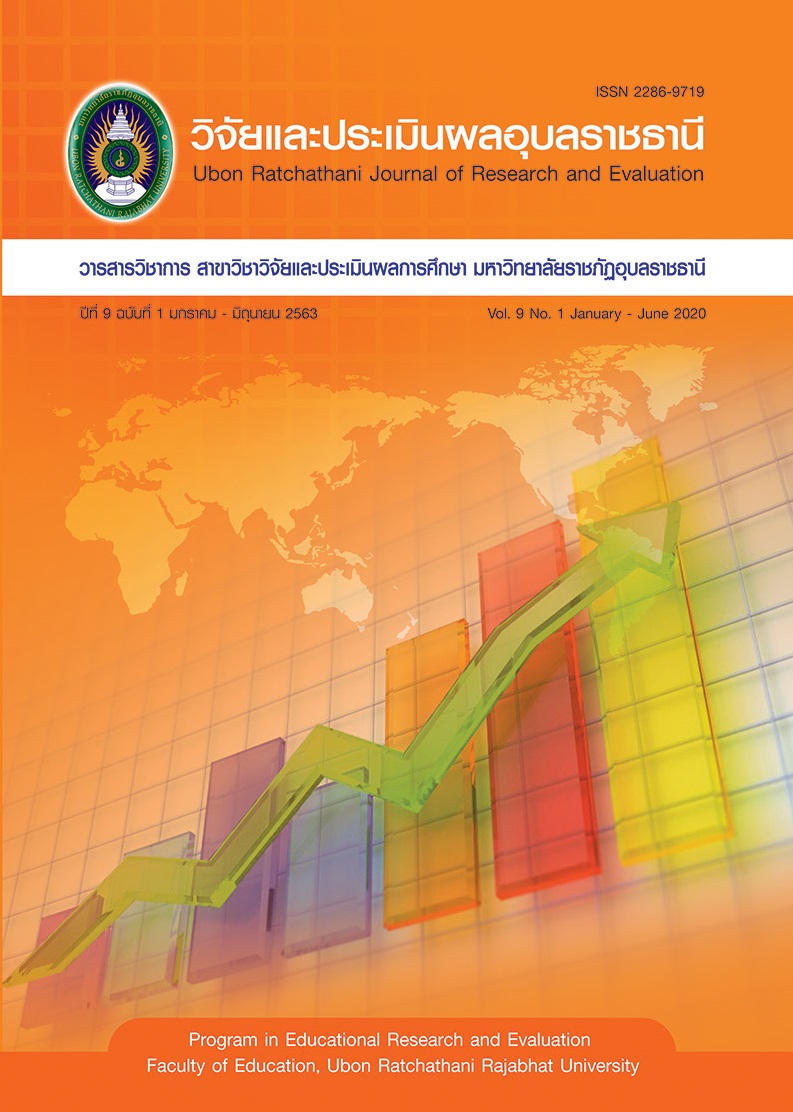A Proposed Model of the Organization of Dramatic Learning Course in the Basic Education Core Curriculum B.E. 2551 for Grade 4 to 6 Students under the Chanthaburi Educational Service Area Office 1
Keywords:
teaching model, dance arts, basic curriculumAbstract
The objectives of this research were: 1) to study the conditions and problems of dance arts learning management in the areas of dance arts learning management and measurement and evaluation of the dance arts teachers for the 4th-6th grade classroom, 2) to study the dance arts teachers’ needs for the dance arts teaching and learning development, and 3) to propose the dance arts models according to Basic Educational Core Curriculum B.E. 2551 (A.D. 2008) for grade 4th-6th students under Chanthaburi Educational Service Area Office 1. The sample used in this research was 16 dance arts teachers for the 4th-6th grade classroom under Chanthaburi Educational Service Area Office 1. The research instruments consisted of a questionnaire and an interview. Statistics included mean and standard deviation.
The research findings were as follows:
1. The dance arts teachers’ learning management conditions were at the high level with the mean of 4.22. The problems related to the measurement and evaluation showed that the tool creation and the measurement were not coverage in cognitive domain, psychomotor domain and affective domain.
2. The dance arts teachers’ need for additional training on the dance arts contents which were problems for learning management was at the high level with the mean of 3.74, by which the dance arts teachers needed to be trained on creative dance arts performance, dance arts project based teaching and dance arts game based teaching.
3. The best dance arts teaching model was the demonstration model, next was 4S teaching model, CIPPA teaching model and Co 5 steps model respectively.
References
ชนัย วรรณะลี. (2539). การศึกษาผลสัมฤทธิ์ทางการเรียนและทัศนคติต่อหน่วยการเรียนการสอนของนักศึกษาวิทยาลัยนาฏศิลป์ (ปริญญานิพนธ์การศึกษามหาบัณฑิต, สาขาวิชาการอุดมศึกษา). มหาวิทยาลัยศรีนครินทรวิโรฒ ประสานมิตร, กรุงเทพฯ.
Wanlee, C. (1996). A study of academic achievement and attitude towards teaching and learning units of the college of dramatic arts students (Master of Education thesis, program in Higher Education). Srinakharinwirot University Prasarnmit, Bangkok. [in Thai].
บุษกร พรหมหล้าวรรณ. (2549). การศึกษาผลสัมฤทธิ์ทางการเรียนและเจตคติต่อการเรียนวิชานาฏศิลป์ของนักเรียนชั้นประถมศึกษาปีที่ 6 ที่ได้รับการสอนโดยการจัดกิจกรรมการเรียนการสอนแบบ 4 MAT (ปริญญานิพนธ์การศึกษามหาบัณฑิต, สาขาวิชาการอุดมศึกษา). มหาวิทยาลัยศรีนครินทรวิโรฒ ประสานมิตร, กรุงเทพฯ.
Phromlawan, B. (2006). A study of academic achievement and attitudes towards learning the dance arts of grade 6 students which was taught by organizing 4 MAT teaching activities. (Master of Education program in Higher Education). Srinakharinwirot University Prasarnmit, Bangkok. [in Thai].
พจน์มาลย์ สมรรคบุตร. (2538). แนวการคิดประดิษฐ์ท่ารำเซิ้ง. อุดรธานี: ภาควิชานาฏศิลป์ คณะมนุษยศาสตร์ สถาบันราชภัฏอุดรธานี.
Samakbut, P. (1995). The concept of Seing dancing invention. Udon Thani: Department of Dramatic Arts: Faculty of Humanities: Institution Rajabhat Udon Thani. [in Thai].
รจนา สุนทรานนท์. (2551). วิธีสอนและเทคนิคการสอนนาฏศิลป์ไทย. ปทุมธานี: ศูนย์ปฏิบัติการพิมพ์มหาวิทยาลัย เทคโนโลยีราชมงคลธัญบุรี.
Suntharanont, R. (2008). Teaching methods and Techniques in teaching thaidance. Pathum Thani: University Printing Laboratory Rajamangala University of Technology Than Yaburi. [in Thai].
เรณู โกศินานนท์. (2548). นาฏยศัพท์ภาษาท่านาฏศิลป์ไทย (พิมพ์ครั้งที่ 2). กรุงเทพฯ: โรงพิมพ์ไทยวัฒนาพานิช.
Kosinanon, R. (2005). Traditional Thai dance technical terms (2nd ed.). Bangkok: Thai Watthana Panich. [in Thai].
ล้วน สายยศ และอังคณา สายยศ. (2538). เทคนิคการวิจัยทางการศึกษา (พิมพ์ครั้งที่ 4). กรุงเทพฯ: ภาควิชาวัดผลและการวิจัยทางการศึกษา คณะศึกษาศาสตร์ มหาวิทยาลัยศรีนครนทรวิโรฒ ประสานมิตร.
Saiyot, L., & Saiyot, L. (1995). Educational Research Techniques (4th ed.). Bangkok: Department of Assessment and Educational research, Faculty of Education, Srinakharinwirot University Prasarnmit. [in Thai].
สุวิทย์ มูลคำ และอรทัย มูลคำ. (2544). วิธีจัดการเรียนรู้: เพื่อพัฒนากระบวนการคิด (พิมพ์ครั้งที่ 5). กรุงเทพฯ: ภาพพิมพ์.
Munkham, S., & Munkham, O. (2001). Learning Management Methodology to Develop Thinking Process (5th ed). Bangkok: Pabpim. [in Thai].
สำนักงานคณะกรรมการการศึกษาแห่งชาติ. (2543). ปฏิรูปการเรียนรู้ผู้เรียนสำคัญที่สุด. กรุงเทพฯ: คณะอนุกรรมการการปฏิรูปการเรียนรู้.
Office of the National Education Commission. (2000). Learning reform is the Child centered. Bangkok: Learning Reform Subcommittee. [in Thai].
Downloads
Published
How to Cite
Issue
Section
License
1. บทความที่ตีพิมพ์ในวารสารนี้ได้มีการตรวจสอบการลอกเลียนงานวรรณกรรมแล้ว ไม่เกินร้อยละ 25
2. บทความที่ตีพิมพ์ในวารสารนี้เป็นข้อคิดเห็น ข้อค้นพบของผู้เขียนบทความ โดยผู้เขียนบทความต้องเป็นผู้รับผิดชอบต่อผลทางกฎหมายใด ๆ ที่อาจเกิดขึ้นจากบทความนั้น ๆ
3. บทความ ข้อมูล เนื้อหา รูปภาพ ฯลฯ ที่ได้รับการตีพิมพ์ในวารสารวิจัยและประเมินผลอุบลราชธานี ถือเป็นลิขสิทธิ์ของวารสารวิจัยและประเมินผลอุบลราชธานี หากบุคคลหรือหน่วยงานใดต้องการนำทั้งหมดไปเผยแพร่ต่อหรือเพื่อกระทำการใดๆ จะต้องได้รับอนุญาตเป็นลายลักษณ์อักษรจากวารสารวิจัยและประเมินผลอุบลราชธานีก่อนเท่านั้น และจะต้องมีการอ้างอิงวารสารวิจัยและประเมินผลอุบลราชธานี ฉบับนั้น ๆ ด้วย






